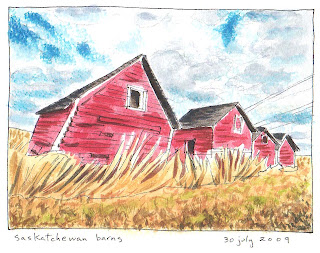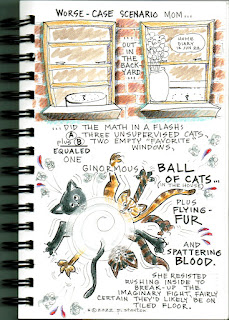This Week in Pictures: Namib Desert
 Miss R. Fadler. Amazing shadows. Looks like a flashlight is pointing directly at those trees. Great "depth-of-field" accomplishment.
Miss R. Fadler. Amazing shadows. Looks like a flashlight is pointing directly at those trees. Great "depth-of-field" accomplishment. Miss N. Buckingham. Such delicate, ethereal colors here, it's hard to believe all these students are using the very same paints...In this version (as in Miss Lee's further down the post) the focus is as much - or more - on the ink-drawing as it is on the painting. Contrast this with Miss Fadler's and Master Davis's, above and Miss Breeding's below. These latter three have nearly done-away-with the ink-drawing in favor of very bold/rich/or deep toned colors - of course any or all lines could be re-inked.
Miss N. Buckingham. Such delicate, ethereal colors here, it's hard to believe all these students are using the very same paints...In this version (as in Miss Lee's further down the post) the focus is as much - or more - on the ink-drawing as it is on the painting. Contrast this with Miss Fadler's and Master Davis's, above and Miss Breeding's below. These latter three have nearly done-away-with the ink-drawing in favor of very bold/rich/or deep toned colors - of course any or all lines could be re-inked.So much for my fearing we'd end up with 12 cookie-cutter paintings each lesson!
 Miss K. Breeding (not quite finished). Does her sky remind anyone else of a famous Impressionist's skies - or is it just me?
Miss K. Breeding (not quite finished). Does her sky remind anyone else of a famous Impressionist's skies - or is it just me? Master J. Wolters. Really fond of those mudcracks. This is one of the few versions to accentuate the distant (also dead) trees in the scene.
Master J. Wolters. Really fond of those mudcracks. This is one of the few versions to accentuate the distant (also dead) trees in the scene. Miss H. Ridge (still in progress). By catching the painting at this stage you can see the primary lesson-to-be-learned this time: if you have dark foreground or near-foreground objects that cut across much of the picture go ahead and paint right over them. Our opaque watercolors will cover pretty well even when the "thing-in-front" isn't near-black. You just need to be sure everything painted so far is bone-dry and that your topping-paint is very "rich" (meaning you've used minimal water and swirled the brush round and round and round on the paint tablet).
Miss H. Ridge (still in progress). By catching the painting at this stage you can see the primary lesson-to-be-learned this time: if you have dark foreground or near-foreground objects that cut across much of the picture go ahead and paint right over them. Our opaque watercolors will cover pretty well even when the "thing-in-front" isn't near-black. You just need to be sure everything painted so far is bone-dry and that your topping-paint is very "rich" (meaning you've used minimal water and swirled the brush round and round and round on the paint tablet). a copy of Miss Ridge's painting as it might appear when finished (through the "magic" of a total amateur using Photoshop).
a copy of Miss Ridge's painting as it might appear when finished (through the "magic" of a total amateur using Photoshop). Master D. Harwell. Well done. Notice the darker blue in the sky...where the color seems to skip-over the under-blue? That's called a "drybrush" effect (for obvious reasons) and is one of the reasons watercolorists like rougher paper - that and it catches or pools-up colors when your brush is overly wet in more interesting ways than the smooth varieties.
Master D. Harwell. Well done. Notice the darker blue in the sky...where the color seems to skip-over the under-blue? That's called a "drybrush" effect (for obvious reasons) and is one of the reasons watercolorists like rougher paper - that and it catches or pools-up colors when your brush is overly wet in more interesting ways than the smooth varieties.








Comments
S. Farver